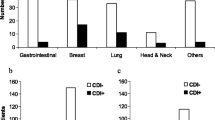Abstract
Goals of work
The goal of this study was to describe the incidence of Clostridium difficile-associated disease (CDAD) in children with solid tumours.
Patients and methods
After documentation of a case of C. difficile-associated pseudomembranous colitis in a patient with neuroblastoma, the presence of C. difficile toxins A and B was prospectively tested in all children undergoing antineoplastic chemotherapy for solid tumours or lymphomas at the “G. Gaslini” Children Hospital in Genoa who presented abdominal pain.
Main results
From January 2005 to December 2006, nine (6%) out of 141 patients treated for solid tumours had C. difficile toxin A detected in their stools in the presence of abdominal symptoms including vomit, abdominal pain and diarrhoea. The majority of patients had a normal neutrophil count at onset of gastrointestinal disease No patient developed pseudomembranous colitis, and none died. All patients received antibiotics and/or antineoplastic drugs previously associated with CDAD.
Conclusions
CDAD may be a complication of children with solid tumours. Since this disease may be life threatening and cause epidemic clusters, this possibility must be kept in mind for the differential diagnosis of abdominal diseases in children with cancer, especially in absence of neutropenia.
Similar content being viewed by others
References
Anand A, Glatt AE (1993) Clostridium difficile infection associated with antineoplastic chemotherapy: a review. Clin Infect Dis 17:109–113
Anonimous (1994) Clostridium difficile. In: Philpott-Howard J, Casewell M (eds) Hospital infection control. Policies & practical procedures. Saunders, London, pp 62–64
Bilgrami S, Feingold JM, Dorsky D, Edwards RL, Bona RD, Khan AM et al (1999) Incidence and outcome of Clostridium difficile infection following autologous peripheral blood stem cell transplantation. Bone Marrow Transplant 23:1039–1042 doi:10.1038/sj.bmt.1701773
Brito GA, Sullivan GW, Ciesla WP Jr, Carper HT, Mandell GL, Guerrant RL (2002) Clostridium difficile toxin A alters in vitro-adherent neutrophil morphology and function. J Infect Dis 185:1297–1306 doi:10.1086/340236
Collignon A, Chaumard C, Vallet-Collomb I, Delepine N (1988) Clostridium difficile in children and adolescents undergoing anticancer and antimicrobial chemotherapy. The possibility of nosocomial acquisition. Pathol Biol (Paris) 36:754–758
Correa AG (2004) Clostridial Intoxication and infection. In: Feigin RD, Cherry JD, Demmler GJ, Kaplan SL (eds) Textbook of pediatric infectious diseases. Saunders, Philadelphia, pp 1751–1758
Cudmore MA, Silva J Jr, Fekety R, Liepman MK, Kim KH (1982) Clostridium difficile colitis associated with cancer chemotherapy. Arch Intern Med 142:333–335 doi:10.1001/archinte.142.2.333
Dubberke ER, Reske KA, Yan Y, Olsen MA, McDonald LC, Fraser VJ (2007) Clostridium difficile–associated disease in a setting of endemicity: identification of novel risk factors. Clin Infect Dis 45:1543–1549 doi:10.1086/523582
Kelly CP, Pothoulakis C, LaMont JT (1994) Clostridium difficile colitis. N Engl J Med 330:257–262 doi:10.1056/NEJM199401273300406
Laret V, Sion C, Bataille C, Hustinx R, Reginster M (2006) Clinical case of the month: clostridium difficile colitis. Rev Med Liege 61:750–752
Miller SD, Koornhof HJ (1984) Clostridium difficile colitis associated with the use of antineoplastic agents. Eur J Clin Microbiol 3:10–13 doi:10.1007/BF02032807
Missaghi B, Valenti AJ, Owens RCJ (2008) Clostridium difficile Infection: A Critical Overview. Curr Infect Dis Rep 10:165–173 doi:10.1007/s11908-008-0028-5
Morris AM, Jobe BA, Stoney M, Sheppard BC, Deveney CW, Deveney KE (2002) Clostridium difficile colitis: an increasingly aggressive iatrogenic disease? Arch Surg 137:1096–1100 doi:10.1001/archsurg.137.10.1096
Pothoulakis C, Sullivan R, Melnick DA, Triadafilopoulos G, Gadenne AS, Meshulam T et al (1988) Clostridium difficile toxin A stimulates intracellular calcium release and chemotactic response in human granulocytes. J Clin Invest 81:1741–1745 doi:10.1172/JCI113514
Schuller I, Saha V, Lin L, Kingston J, Eden T, Tabaqchali S (1995) Investigation and management of Clostridium difficile colonisation in a paediatric oncology unit. Arch Dis Child 72:219–222
Simon A, Ammann RA, Bode U, Fleischhack G, Wenchel HM, Schwamborn D et al (2008) Healthcare-associated infections in pediatric cancer patients: results of a prospective surveillance study from university hospitals in Germany and Switzerland. BMC Infect Dis 8:70 doi:10.1186/1471-2334-8-70
Thielman NM, Wilson KH (2005) Antibiotic-associated colitis. In: Mandell GL, Bennett JE, Doolin R (eds) Principles and practice of infectious diseases. Churchill Livingstone, Philadelphia, pp 1249–1263
Viscoli C, Castagnola E (2005) Prophylaxis and empirical therapy for infection in cancer patients. In: Mandell GL, Bennett JE, Doolin R (eds) Principles and practice of infectious diseases. Churchill Livingstone, Philadelphia, pp 3442–3462
Wehl G, Allerberger F, Heitger A, Meister B, Maurer K, Fink FM (1999) Trends in infection morbidity in a pediatric oncology ward, 1986–1995. Med Pediatr Oncol 32:336–343 doi:10.1002/(SICI)1096-911X(199905)32:5<336::AID-MPO5>3.0.CO;2-4
Wilcox MH, Fawley WN, Wigglesworth N, Parnell P, Verity P, Freeman J (2003) Comparison of the effect of detergent versus hypochlorite cleaning on environmental contamination and incidence of Clostridium difficile infection. J Hosp Infect 54:109–114 doi:10.1016/S0195-6701(02)00400-0
Wilcox MH, Fawley WN, Wigglesworth N, Parnell P, Verity P, Freeman J (2004) Detergent versus hypochlorite cleaning and Clostridium difficile infection. J Hosp Infect 56:331 doi:10.1016/j.jhin.2004.01.027
Author information
Authors and Affiliations
Corresponding author
Rights and permissions
About this article
Cite this article
Castagnola, E., Battaglia, T., Bandettini, R. et al. Clostridium difficile-associated disease in children with solid tumors. Support Care Cancer 17, 321–324 (2009). https://doi.org/10.1007/s00520-008-0507-0
Received:
Accepted:
Published:
Issue Date:
DOI: https://doi.org/10.1007/s00520-008-0507-0



